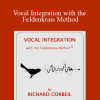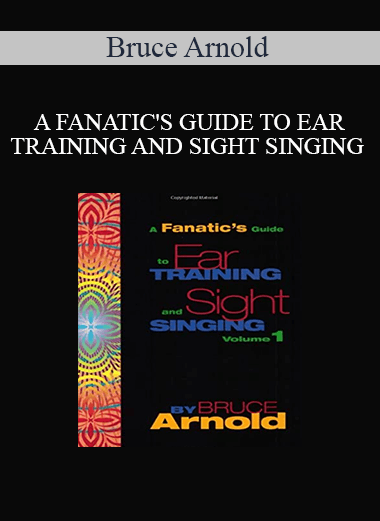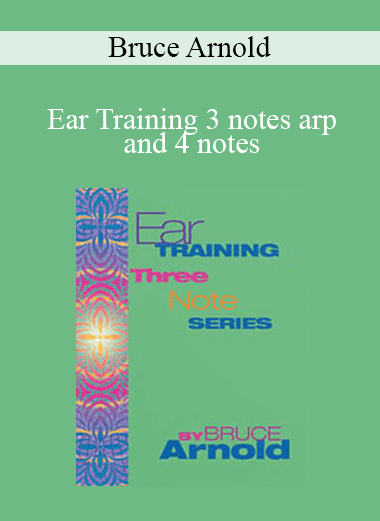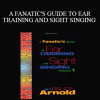Fanatic’s Guide to Ear Training and Sight Singing our best selling singing method.
The idea of singing sound based on a “key center” as opposed to singing an “interval” really began a revolution in the way musicians perceive sound. When a seasoned musician sings a melody, they are not thinking the distance between each note they are hearing, they are singing pitches within a “key center.” Seasoned musicians sing this way naturally after years of playing and singing but with Fanatic’s Guide to Ear Training and Sight Singing a student can fast forward their learning so that they can experience 30 years of ear training in a fraction of the time.
A complete transformation of musical perception with this ear training concept.
You will see from reading the reviews that this system of ear training has changed many musicians’ careers. Even students that are just beginning with music have found that it completely transforms the way they hear and sing music.
If you are only now acquainting yourself with this idea of “hearing within a key center” let’s look at a little history of ear training for musicians
The “Interval” method of Ear Training has been taught in music schools for literally hundreds of years and rarely been questioned. This method is based on singing the distance between each note with no regard to a key center. The problem with this approach is pretty simple. It just doesn’t work when you are trying to sing a melody. Some of the most common problems with singing by interval are:
- A tendency to sing sharp or flat
- Not being able to find the first note of the melody when you start singing a song.
- Inability to maintain your own part when singing within groups or choirs
If you are experiencing any of these problems then you need to get Fanatic’s Guide to Ear Training and Sight Singing and start working towards hearing music based by “key center.”
Why doesn’t interval training work?
If you are trying to sing each note as it flows by in music, there is no way that you can calculate the distance between each note even at a slow tempo much less the usual speed that notes flow by in real time. The only way to instantly know what notes are being played is to ingrain in your mind the sound of each note within a key center so that you know the sounds you are singing in the same way that you see the color blue and know it’s blue.
Our minds can’t process interval relationships at the speed needed to sing notes accurately.
Maybe you have no problem in the classroom when the teacher plays a note and asks you to sing a Major 6th above it, but if you are trying to do this in time as you are actually singing a piece of real music, it becomes problematic, and the problem is compounded the more complicated the music becomes. In the real world, when music is being played in real time, as a musician, your mind just cannot calculate the intervals and analyze what you need to know in order to react properly right away. This isn’t about intellectual ability, it’s about the reality of TIME. So how do musicians identify the sounds they are singing instantaneously?
Key Center is the “KEY”
Here’s how they do it: They use the “key center” of a song and internalize the sound of all 12 notes within that key center. Quite simply when they sing the 3rd they are not thinking that the note is four half steps above the root or in relation to any other note –they are recognizing the sound of a 3rd because they have memorized that sound within a “key center.”
Fanatic’s Guide to Ear Training and Sight Singing teaches you the “Key Center” process
In most cases we recommend you first work with Contextual Ear Training before moving on to Fanatic’s Guide to Ear Training and Sight Singing .
By working with the audio files in the Contextual Ear Training over time, you gain the ability to sing the sound of all 12 notes within a “key center.” For some students this will be a quick and painless rebooting of the way they hear sound; for others it can be a frustrating path with many possible pitfalls.
You have multiple singing method books. Which should I use first?
Fanatic’s Guide to Ear Training and Sight Singing and Contextual Ear Training differences.
Contextual Ear Training and Fanatic’s Guide to Ear Training and Sight Singing are two closely related books. The first and probably most important exercise for a beginner in the Fanatic’s Guide to Ear Training and Sight Singing is the “One Note” exercise. This “One Note” exercise develops the ability to instantly sing any of the 12 pitches over a “key center.” Fanatic’s Guide to Ear Training and Sight Singing requires you to work with a CD and check answers with an instrument to do this exercise. Contextual Ear Training allows you to do this exercise anywhere because the answer is supplied within the audio files, and it is much more portable. Therefore you will improve more quickly if you use the Contextual Ear Training “One Note” exercise because you can do it anywhere that you can take an MP3 player.
Which book should I get or should I get both?
We do occasionally recommend both Contextual Ear Training and Fanatic’s Guide to Ear Training and Sight Singing to students that are working in a choir or other places where they are reading music. With Contextual Ear Training you are not singing notes from a page. It will help you to sing notes from a page once you gain the ability to hear all 12 notes of a “key center,” but it does not build your sight reading skills. Fanatic’s Guide to Ear Training and Sight Singing does contain many exercises that require you to sing notes from a musical staff. So if you are a singer who needs to work on both aspects of your musicianship we recommend both books.
Practicing Ear Training from two different perspectives is the best way to improve.
With this in mind we have created a whole series of books that develop these two aspects of ear training. They basically boil down to listening exercises and singing exercises. For someone just starting our method we recommend: Contextual Ear Training and Ear Training One Note Complete.
Fanatic’s Guide to Ear Training and Sight Singing and Ear Training One Note Complete together make a great ear training program.
Listening exercises found in Ear Training One Note Complete teach you to identify the sounds from external sources such as another band member or a song that you are hearing on your MP3 player. Singing exercises found in Fanatic’s Guide to Ear Training and Sight Singing help you identify the sounds you hear inside you when you are singing, improvising or composing. You need both sides of ear training to become a great musician. The good news is they complement each other so the more you work on one, the more it will the help the other.
Bruce Arnold is here to help you through the process.
Some students can fly through this ear training with no problem. But many musicians have problems and need personal help. But have no fear, Mr. Arnold offers email support for students as they work through this process! So rest assured as you enter this ear training method, that you are not alone, and you can get expert help if you run into problems.
Helping musician for almost two decades!
This method has been transforming musicians for almost 20 years now. It’s one of the best selling Ear Training systems on the market. Simply put: It is successful because it works! BUT the secret weapon is Bruce Arnold. He is only an email away to help you. If you are a beginning or an advanced student seeking to perfect your skills, you can call on Bruce to help you through this process.
Where should you start?
First let’s talk about how you will be doing this ear training. We have found that the best way to do this ear training is with an MP3 player. It allows for many more ways to organize the audio files and is most portable. We do offer physical books and CDs with with some of our ear training products but we HIGHLY recommend you not take this path with our ear training method. Why? Because digital downloads are a much better way to study this ear training as MP3s are much less expensive, easier to organize, more easily portable and cost half as much as physical books with CDs. We also have many ear training products that are ONLY available as digital downloads so it just makes more sense to go the digital route. So unless you REALLY can only use a CD player we sincerely recommend that you buy digital downloads of our ear training products.
Recommended order of books.
For singing we most commonly recommend students start with Contextual Ear Training. and then move on to Fanatic’s Guide to Ear Training and Sight Singing . Also with Fanatic’s Guide to Sight Singing and Ear Training…we recommend you work with Ear Training One Note Complete.
Where do I go after I finish Fanatic’s Guide to Ear Training and Sight Singing ?
Once you have worked through the exercises in Fanatic’s Guide to Ear Training and Sight Singing we recommend you move on to Key Retention Builder.
The FAQs
Over the years we have developed a FAQs resource containing thousands of questions that students have asked over the years. These FAQs are searchable by key word and we recommend that you read these FAQs because they will give you:
- A more complete understanding of the method.
- An insight into the problems and solutions others have had with this ear training.
- Encouragement and determination that you can do this, and that it just takes daily dedication.
- The proof that EVERYONE that has really put their mind to it has mastered this ear training without exception.
- The reason why dedicating a short amount of time each day: 5 to 10 minutes 5 to 10 times a day will be all it takes to master this ear training.
Muse Eek and Bruce Arnold’s Blog
Muse Eek has multiple blogs that deal with ear training and other subjects. Along with the FAQs you should find answers to your questions or useful information. Mr. Arnold also has a Blog on ear training and other musical topics on his artist site. This Blog can be very useful to learn about ear training and other topics related to music and guitar playing.
Some of the topics covers are linked below.
- Ear Training Fundamentals plus common student mistakes
- Kids Ear Training Courses The Best Early Music Education
- Tone Deaf and why you most likely don’t have this condition.
- Ear Training Blog by Bruce Arnold for Muse Eek Publishing
Helpful Links to other products:
Please find links to other ear training products associated with the “One Note Series” below:
- MetroDrone® is single most important addition to the Ear Training One Note Complete course. This multi-practice tool can be used to develop your sense of key with most everything you practice. It also will develop many aspects of your time and feel. You can read more about this here. You can purchase the MetroDrone® course as an iphone app or as downloadable MP3s.
- 25 Ear Training Tips. This course contains 25 videos that talk about ear training, how to practice it, clears up many misunderstandings and generally makes sure you are doing the right thing when you practice ear training
- Practice Perfect Applied Ear Training This series of 10 courses is recommended when you are getting 50% correct notes on any level of the Ear Training One Note Complete.
- Direct Application Ear Training Series is recommended when you are getting 50% correct answers on any “One Note” level. Similar courses to the Practice Perfect Applied Ear Training
- Melodic “Two Note” Method is also recommended when you are getting 50% correct answers on any “One Note” level.
- Instrumental Color Series is recommended when you are getting 50% correct answers on any “One Note” level. It is recommended that you go to this page and test your one note ear training ability with the MP3s that are found on this page. Many times students have difficulty hearing “one note ear training” when other instruments are used. Usually you won’t need to work with all instruments found on this page but please check. This is also a great method to get because it gives you 5 levels of exercises, major and minor key centers as well as exercises in a major and minor key center.
Additional Information for Fanatic’s Guide Volume One:
- Digital IBSN: 978-1-59489-876-1
- 85 pages and 12 MP3s.
What people are saying:
- WOW. This ear training actually works. Easy? Maybe for some, but not for me. It took about one year to get to 60%. Mr. Arnold was very encouraging throughout and I probably wouldn’t have made it without him. Mistakes in judgement? Yes, Yes , Yes… I read the book that comes with the course and then did so many things contrary to what it says, I should have my head –or my eyesight– examined. Again, Mr. Arnold said this was typical because you are starting a new thing and mistakes will happen. Was I a pain in Mr. Arnold’s rear? Yes, he actually asked me to write this once I was doing OK with the ear training just so people could see the frustration that a student sometimes goes through and how important it is to have a mentor cheering you on! Thanks Mr. Arnold, I wouldn’t have made it without you!. T. Chad
- I was working with the Advanced Level of the Ear Training One Note Complete within two weeks. Seems like I’m more of the unusual case after reading these other comments. A few observations that I found important. Get in touch with Mr. Arnold right away. The guy actually helps and I had some misconceptions that he cleared up right away. One thing that is important is think of the Ear Training One Note Complete as the “Clinical” exercise to get your going with the right ear training technique i.e. Hear pitches in relationship to a key center. Then there is the singing side, Contextual Ear Training. A much harder course that is kick’n my behind, but I see it’s importance. Then there are the Practice Perfect Applied Ear Training Courses. Ton’s of them to be exact. This is were the rubber meets the pavement. Think of these books as your direct application of the clincial stuff you learned in Ear Training One Note Complete to real music. Multiple styles are available and working with these real music examples has shown me many weaknesses in my ear training ability. Mr. Arnold has directed me to other courses that will help me solve these issues. So again, contact Bruce, he’s great. Answers right away and you can tell he cares about you improving your musicianship. He actually wants me to be better than I even thought I could be so that is inspiring. H. Duckworth
- I have been using this for about two years and am at the third level with about an 80% recognition rate. I would like to share a method to accelerate the pitch recognition process (the methodology has been outlined here in other reviews, so I will forgo a description, adding only that it is effective for anyone who is willing to put in time on a regular basis – in my case, about twenty minutes daily). In Itunes, create playlists for each level as follows: Level x naturals, Level x sharps and flats, level x all pitches. Now place the appropriate tracks in each folder. Place the playlists in shuffle mode. Now drill just the naturals (no sharps or flats). If you have trouble with the A’s and D’s (as I did), make a playlist with only the A’s and D’s – you get the idea. This gives you the ability to ‘drill down’ on trouble spots. I had trouble with F# and G#, getting them mixed up. By isolating them and shuffling them I sorted them out in about two weeks. Likewise you can create a playlist with just the notes in very high register, for example, or very low register – whatever gives you trouble. After you get facile at recognizing the naturals and accidentals separately, you can slowly start integrating the accidentals into the naturals – just add the flat seven (A# in this system) to the naturals, then add the flat three (D# in this system), you get the idea. Eventually you will be drilling all twelve tones, and hitting all of them almost all the time. Approached this way this is one of the best ear training programs I have ever used, and it is actually extremely time effective and concise. For the asking price, it’s a no-brainer. Seriously. Also check out Fanatic’s Guide to Sight Singing and Ear Training Volume One, which works very well with this product. And have fun! M. Callaghan
- My 7 year old son and I really enjoy these materials by Bruce Arnold. We have One Note Complete, Contextual Ear Training, and A Fanatic’s Guide to Ear Training. We have been using One Note Intermediate and Contextual for just over one month. My son loves to do this ear training program, especially “name that note!” We home school, and we do Ear Training One Note and Contextual Ear Training as soon as we get out of bed, and then later in the school morning. I also do both programs later in the day, especially when I am working in the kitchen. My son almost always listens in, and sings along, or names the note, even when he is playing in the next room. After just one month, my son can accurately name all 7 diatonic notes, but none of the non-diatonic yet. I can accurately name C, D,G, and B. I can sometimes get A and F, and I hardly ever get E (yet!). For Contextual, both my son and I can sing Root (Do) for all the keys, although sometimes the minor keys do give us a bit of trouble. We can both sing 3 (Me) most of the time, but 3 still needs work. My son was able to sing 3 much sooner than me. I asked him how, and he said he “just knows what 3 sounds like.” As for me, I got every single 3 wrong for over two weeks, and I was doing them at least 5 to 7 times per day! Then one day, I started getting a few of them correct! Then within a few more days, I was getting most of them correct. This system really does work. After listening to the cadence, the sound of the 3 would just form in my mind. We have been singing 5 (So) for about a week. 5 is coming along much faster than 3. Both of us could sing some 5’s right away. We also continue to review Root and 3. This system is really fun to use and its working for us! F. Campbell





5 reviews for Bruce Arnold – A FANATIC’S GUIDE TO EAR TRAINING AND SIGHT SINGING
There are no reviews yet.